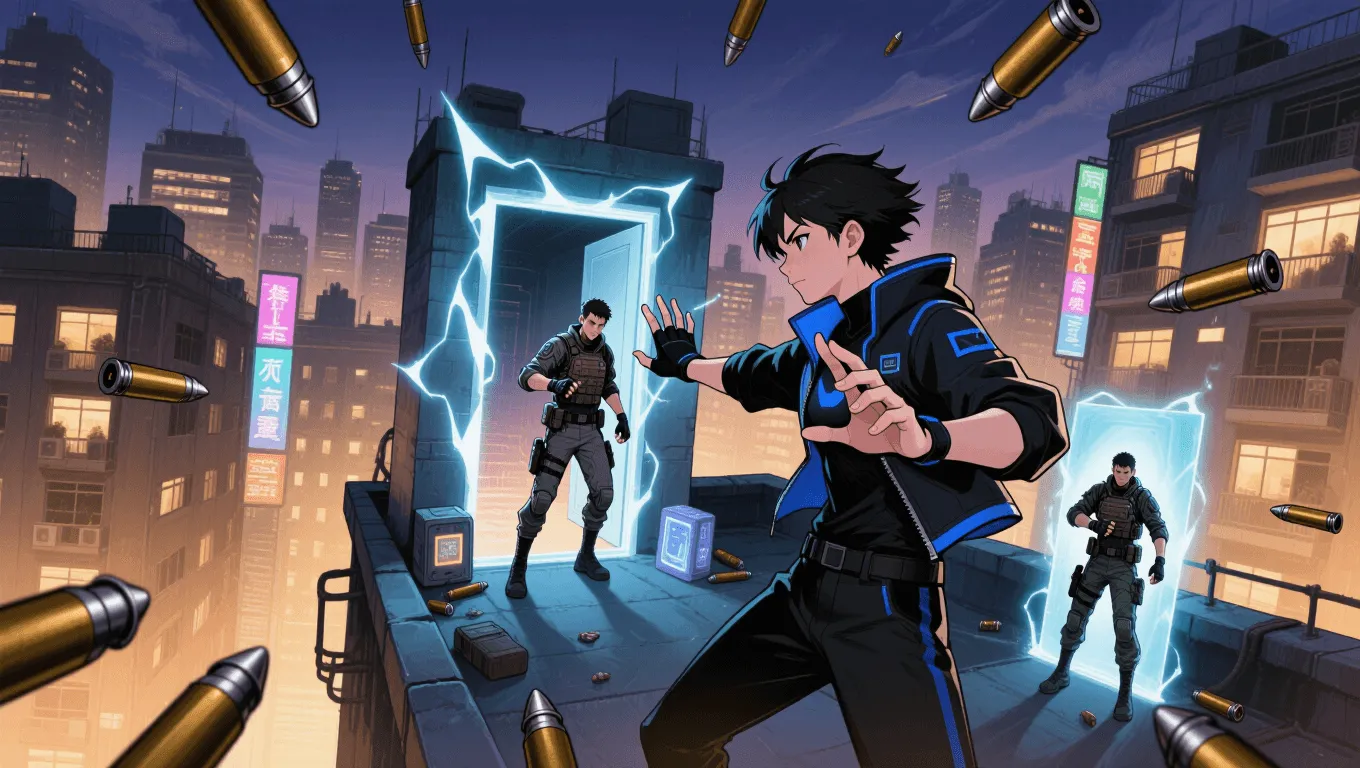What Is Dimensional Rift

Dimensional Rift Video Demo 🎬
Table of Contents
Dimensional Rift is a superpower that allows a person to open controlled tears in the fabric of space, sometimes time, to connect two or more locations or realities. With a precise gesture or mental focus, the user slices a rift—an edged seam of nothingness—that functions like a portal, corridor, or spatial shortcut. This power sits at the intersection of portal generation, interdimensional travel, and spatial manipulation. It can create instant escape routes, ambush vectors, or access to pocket dimensions for storage and shelter. For readers exploring or comparing abilities, see the evolving catalog on the superpower wiki and try a random pick from the random superpower generator.
Common related terms include rift manipulation, space-time tear, wormhole creation, breach opening, and spatial rupture. Depending on mastery, the rift can be temporary or persistent, flat like a doorframe or irregular like a jagged wound, and safe or hazardous to cross.
Core Abilities of Dimensional Rift
Controlled Portal Creation
The core function is forming a door between two points—across a room, across a city, or across realities. The user defines entry and exit, stabilizes the boundary, and determines who or what can pass through. Advanced users can angle rifts midair or anchor them to moving objects.
Interdimensional Transit
Beyond point-to-point travel, the power can open to parallel worlds, pocket dimensions, astral planes, or liminal waystations. Expert users chart “safe lanes” in the interspace to avoid temporal drift or hostile realms.
Spatial Redirection
Rifts can redirect momentum. A punch, bullet, or energy bolt can disappear into a seam and reappear from another—turning defense into offense. Skilled users “curve” trajectories by chaining exits.
Rift Sensing and Breach Detection
Many wielders develop a sixth sense for thin places in reality. They can feel where space is stressed, detect existing breaches, and choose safer spots to cut. This includes recognizing resonance signatures left by other teleporters.
Severing and Containment
The edge of a rift can act like an infinitesimal blade. While most heroes avoid lethal edges, the seam can slice ropes, beams, or even disarm an opponent by trimming a weapon or severing a projectile’s path. Conversely, rifts can be folded to encapsulate foes in a loop or corridor until released.
Pocket Dimension Access
Users often maintain a keyed vault—an extradimensional cache for gear, prisoners, or refugees. This is invaluable for logistics and stealth operations.
Breach Sealing
Some practitioners can stitch existing tears shut, mending the local topology to prevent incursions, disasters, or temporal spillover.
Application / Tactical Advantages in Combat
Mobility and Positioning
Dimensional Rift turns the battlefield into a chessboard. Instant flanking, vertical repositioning, and rapid extraction keep allies alive and enemies guessing. A squad can retreat through an exit that the enemy cannot even perceive.
Line-of-Sight Control
Rifts cancel typical cover. If the user can see, map, or remember a location, they can bypass walls and shields, delivering precision strikes or evacuations without breaching doors.
Force Multiplication
Redirected attacks allow the team to reuse enemy fire. A beam aimed at the user emerges behind the attacker. Projectiles can be “stacked,” sending multiple angles into a target at once.
Area Denial and Crowd Control
By shaping several small rifts, the user creates hazardous terrain—corridors that return a charging foe to their original spot, loops that trap drones, or exits that dump adversaries into holding cells.
Logistics and Recon
Stealth insertions, supply drops, and rapid rescues become routine. Micro-rifts serve as periscopes or microphones—brief peeks without committing a full portal.
Level: Level 1 🏙️, Level 2 🌇, Level 3 🌃
Level 1 🏙️ — Neighborhood Tear

Scope: Short-range, same-reality rifts within line of sight (up to a few city blocks).
Stability: Seconds at a time with visible edges and minor spatial static.
Capabilities:
-
Open/close door-sized portals for the user and one ally.
-
Redirect simple projectiles (e.g., arrows, small arms) from predictable angles.
-
Create a small pocket cache for personal gear.
-
Sense weak spots in nearby space (a “tingle” before other teleporters arrive).
Tactics: -
Quick escapes, rooftop flanks, alley-to-alley pursuit breaks.
-
Redirect a single attack to force an opponent to self-expose.
Training Focus: -
Breath-based stabilization and anchor visualization.
-
Safety drills to avoid clipping moving objects.
Risks: -
Misaligned exits cause vertigo.
-
Glimpses of unsafe interspace if concentration breaks.
Level 2 🌇 — Citywide Cartographer

Scope: Multi-kilometer range, indirect line of sight via memory or beacons.
Stability: Up to minutes; can maintain two rifts simultaneously.
Capabilities:
-
Team transport (small squad) with momentum conservation control.
-
Multi-angle redirection of energy beams or heavy projectiles.
-
Temporary containment corridors and looped paths.
-
Sealing minor breaches created by others.
-
Access to a moderate pocket dimension (room to small warehouse).
Tactics: -
Ambush chains: open behind cover, attack, withdraw before detection.
-
Counter-sniper plays by warping lines of fire.
-
Evacuation of civilians across blocked streets or burning structures.
Training Focus: -
Exit mapping using landmarks and resonance beacons.
-
Edge dampening to avoid accidental cuts on allies.
Risks: -
Overextension causes rift flutter, risking item loss to interspace.
-
Environmental spillover (dust, pressure differences) if moving between altitudes.
Level 3 🌃 — Cosmographic Architect

Scope: Intercontinental and interdimensional. Can open to parallel timelines with caution.
Stability: Hours if anchored; can maintain a network of rifts and switch them dynamically.
Capabilities:
-
Strategic logistics for whole teams, vehicles, or small aircraft.
-
Precision phase-cutting (nonlethal disarms to structural severance).
-
Interspace waystations with custom physics (time-dilated rest vaults).
-
Sealing major breaches and neutralizing rogue wormholes.
-
Selective permeability: gate scans, ID locks, and directional filters.
Tactics: -
Theater-wide repositioning; instant reinforcement of distant fronts.
-
Catastrophe response (earthquakes, fires, floods) with mass evacuation.
-
Reality quarantine to stop extradimensional pathogens or entities.
Training Focus: -
Multinode anchor management and precomputed safe vectors.
-
Negotiating interdimensional treaties and corridor etiquette.
Risks: -
Temporal drift, causality loops, or attention from predatory realms.
-
Ethical hazards of altering outcomes via timeline adjacency.
Limitations of Using the Dimensional Rift
-
Anchor Requirement: The user often needs a remembered location, a line of sight, or a beacon. Unknown coordinates increase chance of misdrop.
-
Cognitive Load: Each open rift consumes focus. Multirift operations cause headaches, memory fog, or blackouts.
-
Momentum & Orientation: Transport preserves or cancels momentum depending on control. Inconsistent settings can injure passengers or cause falls.
-
Environmental Mismatch: Air pressure, temperature, and gravity may differ between points. Abrupt changes risk hypoxia, sonic booms, or debris storms.
-
Material Limits: Extremely dense or reality-anchored materials (nullstone, anti-phase alloys) resist being moved through rifts.
-
Interference: Anti-teleportation fields, geomantic wards, or chaotic storm fronts can jam rift formation.
-
Ethical/Legal Constraints: Unregulated gateways violate borders, private property, or dimensional accords. Responsible use requires consent and containment.
Weakness Against What Other Superpowers
-
Nullification Fields: Powers that dampen spatial or psionic output collapse open rifts and prevent new ones.
-
Gravity Distortion: Extreme gravity wells bend exits unpredictably, tearing rifts or slingshotting travelers into unsafe trajectories.
-
Time Locks: Temporal stasis, time rewind anchors, or chronal cages freeze the seam or desync entry/exit points.
-
Sealing and Barriers: Force field generation tuned to interphase frequencies blocks portal lips from forming flush to surfaces.
-
Predictive Combat (Precognition/Hyper Awareness): Foes who foresee exit vectors can counter-flank or trap the user in their own loop.
-
Reality Anchors: Artifacts keyed to a universe’s constant can pin space, making rifts shallow or forcing them to snap shut.
-
Signal Scramble: Beacon jammers and dimensional noise generators create false positives, luring exits into traps.
Synergistic Power Combos
-
Telepathy + Dimensional Rift: Secure coordination while teammates move through different exits; telepaths also help maintain calm to stabilize seams.
-
Gravity Pulse / Gravity Shield: Shape approach vectors, slow incoming threats at the exit, or compress debris before dumping it harmlessly elsewhere.
-
Illusion Casting: Mask the presence of a rift, hide exit glow, or project decoy portals to bait enemies.
-
Kinetic Absorption: A partner absorbs incoming force at an entry, then releases it through a different exit for amplified knockback.
-
Force Field Generation: Build safe vestibules around exits, equalize pressure, and create customs-like checkpoints.
-
Hyper Awareness: Spot micro-tells right before an opponent dives through a seam; prevents ambushes and accidental collisions.
-
Ice Manipulation / Pyrokinesis: Environmental prep at the destination—freeze floors or flash-heat air—to control footing and visibility as enemies arrive.
-
Healing Touch: Mitigate motion sickness and rift fatigue after high-tempo operations.
Known Users
-
A tactical portal specialist from a metropolitan defense unit who maintains a time-dilated rescue vault for mass-casualty events.
-
A renegade courier who runs black-market routes across parallel city echoes, relying on hyper awareness to avoid patrols.
-
A mystic navigator trained to seal fractures left by reckless teleporters, liaising with interrealm custodians.
-
For a pop-culture analogue, see the Marvel character Blink, a combat teleporter known for creating stable portals and redirecting attacks.
-
Fans of sorcery-driven travel may also think of Magik (Illyana Rasputin), whose stepping discs ferry allies across realms.
-
Strategic, reality-aware practitioners resemble Doctor Strange when using gate-like constructs and protective wards around exits.
By understanding how Dimensional Rift works—its anchor logic, safety protocols, and synergies—teams can turn space itself into a friendly tool rather than a fixed obstacle. For more powers that mesh well with rift manipulation, browse the full superpower wiki or try your luck with the random superpower generator.
